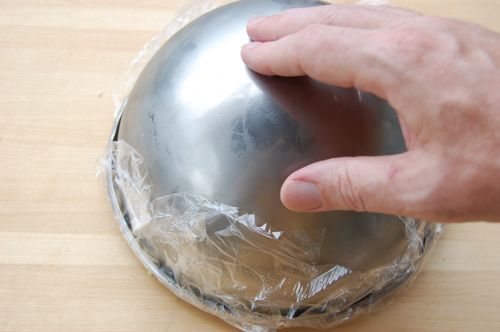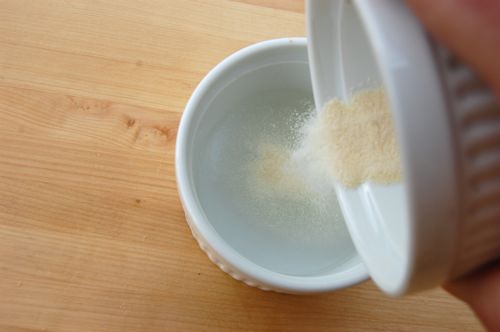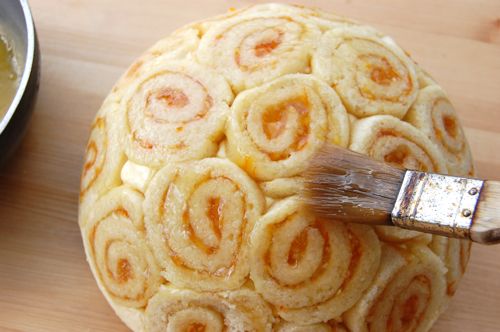Making Charlotte Royale

Just like a Charlotte russe, a Charlotte royale can take a variety of forms. This domed version is probably the classic, though I’ve seen lots of flat ones made in rounds as well. They can be just about any flavor. Mango is a true delight. It starts with a sheet of joconde, half as thick as my regular recipe calls for. It should be only lightly browned so that it remains flexible enough to roll. About like so:

Loosen it from the pan as soon as it emerges from the oven.

Then lay on a sheet of parchment and a rack.

Flip everything over and peel away the paper.

Apply another parchment sheet and another rack (or an upside-down sheet pan)…

…and flip it back. Remove the top piece of parchment and allow the cake to cool completely.

Reader Ed had the suggestion that instead of making one long jelly roll, which would leave leftovers of jelly roll and a bottomless Charlotte, I should use half the sheet for the roll and half for a bottom. It’s an excellent idea and it makes the finished Charlotte a whole lot easier to serve. Depending on the size of the form you’re using it can result in a shortage of pieces to completely cover the Charlotte, though that certainly isn’t the end of the world. I’m going with Ed’s suggestion. So I’ll cut the sheet in two…

…then trim off the crusty edges to make it easier to roll.

Now I’ll apply some orange marmalade.

I’ll spread it over evenly, but leave a small ridge at the far end to give the roll a “center” as it were…something for the cake to roll around.

Then I’ll just roll up the marmalade-covered half. To give the Charlotte a somewhat more refined appearance you can roll the joconde the “short” way. This will give you smaller cross-sections, though the sheet can be a bit harder to roll tightly and to slice (you need to cut the pieces quite thin so you have enough of the small pieces to cover). Either way the roll will crack here and there. Fear not.

I’ll wrap that in plastic wrap…

…then give it a gentle roll on the board to help ensure a tubular shape. I’ll then stash it in the freezer for a few hours (or a few days).

Then I’ll lay down a cake circle on the other half of the joconde sheet, one that’s the same size as my form, in this case eight inches. Then I’ll trim away the excess which I’ll eat when no one’s looking.

There’s my Charlotte bottom. Still needs a little trimming, but it looks good.

Now I’ll fetch my mold. You can use any sort of round-bottomed bowl, but the advantage of a stainless steel mold like this is that it won’t react with anything (like acidic fruits). Hey! Who’s the dork holding the camera?

To keep a round-bottomed bowl steady while you work, just place it in another smaller bowl that has a flat bottom.

Press in a layer of plastic wrap, which will ensure no sticking.

Now simply slice your jelly roll into 1/4″ to 3/8″ slices…

…and lay them into the mold, pressing gently.

Paint the interior with the rum syrup and stash the whole works in the fridge while you prepare your mango mousse.

When the mousse is ready, spoon it into the mold.

Apply the bottom (cardboard side up) and press it down firmly. Refrigerate everything for a minimum of three hours.

When you’re ready to finish the Charlotte, simply up-end the mold, loosen the plastic from around the sides and lift it off.

Peel back the plastic wrap and set your creation aside while you make the glaze.

Combine the water and gelatin and let them sit…

…while you heat the sugar and orange juice together in a small saucepan.

With the juice mixture at a simmer, add the gelatin mixture and stir until it’s melted.

Place the saucepan in an ice bath to cool it and encourage the gelatin to begin setting up.

Keep scraping/stirring with a spatula so it doesn’t set up in a mass. When you start to see tracks on the bottom, the glaze is ready.

Just paint it onto your Charlotte and you’re done.

The Charlotte is ready to serve immediate, but can be refrigerated for several hours prior to serving. It’s great served with the traditional sauce of crème anglaise, spiked of course with a little rum.